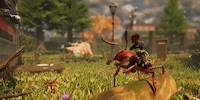
Background information
Through the park with the insect battle tank: I played "Grounded 2"
by Debora Pape
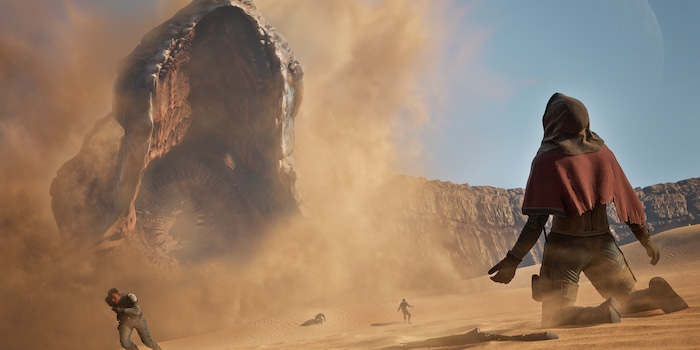
Dune: Awakening turns the legendary desert planet Arrakis into a playground for amateur architects and spice prospectors. Although the game still needs some tweaking, it’s already just as addictive as the planet’s highly coveted resource.
Shoot, shoot, shoot! There’s a giant sandworm hot on my heels. The life-saving rocks I’m heading for are still at least 100 metres away and my sandbike’s tank is practically empty. I’ve got no choice but to boost it and hope there’s enough fuel. Jeronimoooo! Made it. I’ve narrowly missed sinking into the razor-toothed maw of a Shai-Hulud, taking my hard-earned loot along with me. Staying true to the book it’s based on, the Arrakis desert in Dune: Awakening takes no prisoners.
Dune: Awakening is Funcom’s latest MMO (Massive Multiplayer Online). The genre’s familiar territory for the Norwegian studio, which made a name for itself with the likes of Age of Conan, The Secret World and Conan Exile. For better or worse, Dune has a lot in common with Funcom’s previous games. I spent around 20 hours rooting around in the sand in the PC version. In other words, far too little time to make a definitive judgement on the game. But certainly long enough to get hooked.
Dune: Awakening is a third-person survival game. This tracks well with the setting used in Frank Herbert’s novel, Dune. Consisting mostly of sand, the planet of Arrakis is regularly battered by deadly storms. Gigantic, monstrous worms plough their way through the earth. While the world and inhabitants match those in the original book, the story takes a different course. In the game, the main character of the novels, Paul Artreidis, was never born. The Fremen, the desert people native to the planet, have disappeared. Instead of dying in an assassination attempt, Duke Leto Atreides is fighting a raging war with the hostile Harkonnens.
I’m sent to Arrakis as a prisoner to investigate the disappearance of the Fremen. «Everything depends on this,» the mysterious women’s order Bene Gesserit tells me. If it’s so important, why are they relying on a jailbird like me? The story starts out flimsy, and has remained totally incidental ever since.

The element of survival is much more central to the game. Standing under the sun’s glare for too long has fatal consequences. My top priority? Collecting water. Whether it’s for quenching my thirst or maintaining the machines in my base, I can never get enough of it. But the base issue doesn’t come until later on. I drink the first few drops of water I can extract from flowers myself. This gives me enough energy to collect granite and plant fibres. I can then use them to build my first pieces of equipment. As is the case in most survival games, the cycle in Dune: Awakening consists of gathering resources, crafting equipment, expanding your base and, of course, killing enemies.
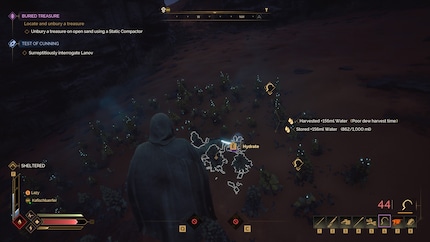
As the game progresses, you learn new and more efficient ways of collecting water, from plant-harvesting sickles to air filters. The most direct method, however, is using blood extractors. Bandit camps scattered across the map are basically your personal filling stations. Once an enemy has been dispatched, Doctor Philipp rocks up with a big syringe and fills up his blood bags. Contrary to typical game logic, I opt to build my base close to my enemies. That way, I don’t have far to go when my inner vampire stirs during the night.
Thirst is a constant part of life in the game and your levels need monitoring at all times. At one point, I’m so engrossed in expanding my base that I die of thirst. And since I haven’t chosen my base as a respawn point, I’m forced to trek over half the desert to get back to my body. When you die, you drop the resources you’ve collected, keeping only what you have on you. If it’s a sandstorm or the greedy mouth of a sandworm that finishes you off, not even that will be safe. I learn this the hard way when I try to move my base and end up in the belly of a powerful Shai-Hulud. When I respawn, I’m left with nothing but a pair of cloth underpants. It even ate my money!
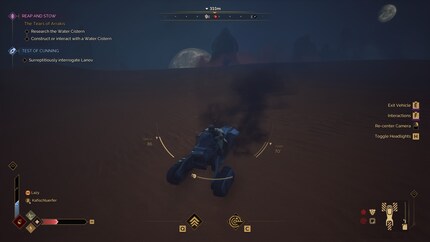
The rest of the time, there’s always something breaking. Your equipment, for example. Although you can repair it, you can only do so at a repair station, with the right blueprint and the necessary resources. As if that weren’t bad enough, you can’t completely repair things. The shelf life of your items is constantly decreasing. Arrakis is a tough place.
When I’m not exploring the desert on my self-built sandbike, a sand buggy or, later, an ornithopter, I’m looking after my base. With a growing selection of modules at my disposal, I can rustle up a new home in next to no time.
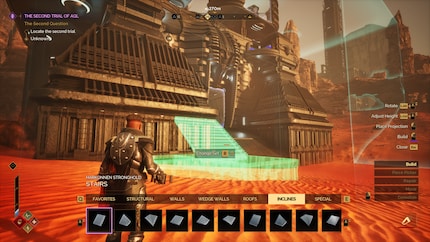
I fit my base with generators, a blood extractor, a recycling machine and a fabricator. The latter’s especially important because I use it to make equipment. To my delight, the machines automatically take the resources they need from my storage boxes. There’s nothing I loathe more than storage management.
As time goes on, the variety of available roof, wall and window elements grows. Even so, most of the buildings on Arrakis still resemble prefabricated buildings from the Soviet Union. Both mine and those of other players. The desert planet and its settlements seem like a stomping ground for failed architecture students.
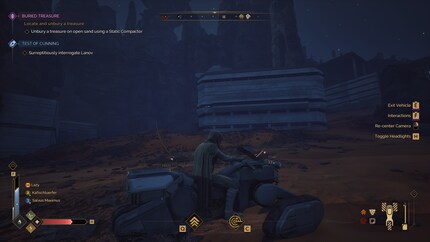
By MMO standards, encounters with other desert explorers are rare. Their settlements, on the other hand, are everywhere. Even so, my fear that their postmodern superstructures could disfigure the game world hasn’t come to fruition.
Before playing Dune: Awakening, I had some concerns about the game world. I wondered how varied a desert could possibly look. As it turns out, very varied indeed. One way Funcom achieves this is by playing with colours and contrasts. As a result of the dynamic change between day and night, the same landscape looks pale grey in the morning, threateningly red under the burning sun and soothingly blue in the moonlight. Huge rock formations, reminiscent of an alien Grand Canyon, also tempt you into exploring. There are basically no limitations. With enough stamina, you can scale the highest peaks.
The level design doesn’t just allow for upward travel – you can go downwards too. As I’m exploring a crashed spaceship in a huge ravine, I can use a hover module to glide deeper and deeper under the planet’s surface. The caves are so labyrinthine that it takes me a good half hour to get back.
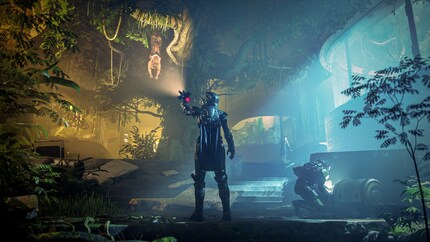
Not even the planet’s vast sand dunes are boring or empty. As I can build a sandbike relatively early on, I quickly make progress. I just have to be careful not to attract any sandworms on my travels. The legendary monsters don’t take long to appear when I’m cruising around with the pedal to the metal. If one of the gigantic worms starts chasing me, I’ve got to pick up the pace. It’s only once you’re on solid ground that you’re safe from the creatures. Sandworms aren’t the only thing that can make you lose all your equipment. You also have to watch out for Coriolis storms.
Funcom has captured the danger of the desert brilliantly. Traversing its sprawling, open spaces is nerve-wracking, with threats even lurking in the sand itself. If you suddenly hear an ominous hammering sound, it means you’re riding over drum sand, which can swallow you up, bike and all. If the gaping mouth of a Shai Hulud comes snapping out of the ground at the same time, you’re a goner.
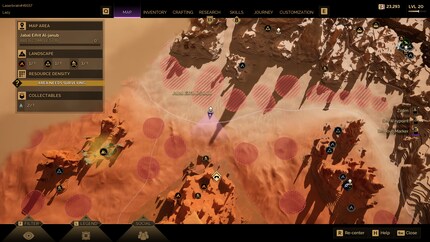
I’m curious to see what awaits me in the Deep Desert. This particularly dangerous zone offers the best loot and plenty of spice, but also the most dangers. It’s a PvP area, where players can attack each other and fight over their treasures. Elsewhere in the world, only spaceship wrecks are PvP zones. Since certain crafting resources are only available there, visiting these crash sites is unavoidable. The few times I’ve encountered anyone on my own forays to the wrecks, we’ve just given each other a friendly wave.
Being part of a team gives you an advantage in PvP. As for the rest of the game, I’ve been getting along well on my own so far. Mind you, being able to divide up base construction tasks would be nice.
Bandits, who have camps all over the place, are always up for a fight. They’re the least exciting part of the game so far. There only seems to be one type of enemy: humans. If they attack you with a sword, there’ll be a quick tussle. Blocking, countering and breaking through their energy shield at the right moment does the job.
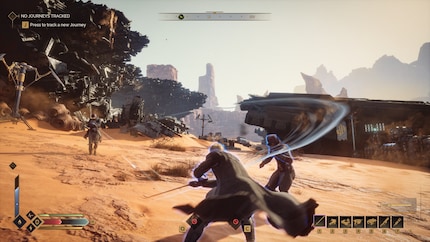
I shoot enemies in the head with a standard selection of pistols, shotguns, sniper rifles and so on. Although there are different character classes (I’ve opted to be a Mentat technician, able to set up turrets and shoot clouds of poison), this hasn’t injected much variety into the game so far. I’m hoping for a lot more later on.
The same goes for quest design. In typical MMO fashion, quests are always the same. You’re either collecting something, killing someone or both. Even the quests marked as story follow this pattern. In Weapons of War, you have to research a sword, craft it, then use it to kill 15 enemies. It’s a totally monotonous endeavour, and the weapon’s actually worse than my previous one. Occasionally, there are quests with semi-spiritual undertones and dream sequences. However, they’re not particularly exciting either.
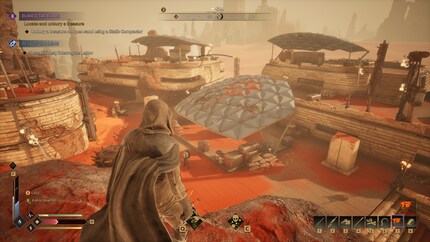
Funcom urgently needs to make the game more accessible. Many aspects of Dune: Awakening are cryptic and complicated. For instance, I originally thought each piece of equipment was colour-coded to indicate its rarity, as is the case in all role-playing games. Instead, orange, green and blue represent places where you can find the resources for a given piece of equipment. I still don’t understand what the two drop-down menus on my machines with «Circuit 1-8» mean. And then there’s the construction and research menu. Instead of displaying everything, the first menu item only shows you construction recommendations, most of which are nonsense.
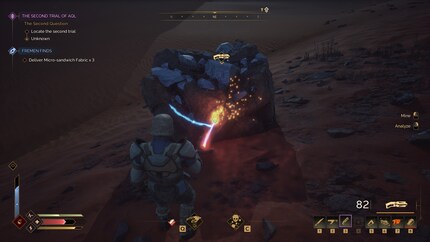
Not being able to see everything at a glance reminds me of Age of Conan. While playing the 2008 MMO, I was hardly able to distinguish a dagger from a piece of wood in my inventory. When my friend who was much further along in the game came online, I bombarded him for an hour with questions about things that weren’t clear to me.
The countless gadgets also make things unnecessarily cumbersome. You have eight quick-selection slots, required for everything from weapons to bandages and binoculars. I already have more devices than slots. It doesn’t matter if you’re drawing blood, mining ore, repairing vehicles or extracting water from plants – you always have to choose the right tool for everything first. Why can’t you just press a button that automatically selects the tool? There’s even a device for stowing or using your vehicles.
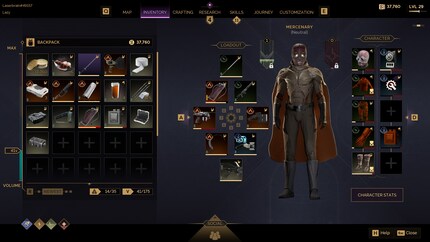
Despite some shortcomings, Dune: Awakening has captivated me. I like the calm tempo of the game. Rather than fighting my way through hordes of enemies, I’ve spent most of my time exploring and managing my base. In my first 20 hours of game time, I’ve been motivated by curiosity and the typical upgrade loop. Time and again, new equipment or a new device lures me out of my safe base and into the menacing world.
It helps that Dune: Awakening looks seriously cool and is accompanied by a great soundtrack. It doesn’t quite match the opulence of Hans Zimmer, who composed the score for the Dune films. But when the sound in the game swells, it creates an atmosphere just as gripping. I can get over the fact that battles and quests are a bit monotonous.
If Funcom can tweak the accessibility and simplify using tools, I see a bright future for this dusty planet.
Dune: Awakening is now available for PC and was provided to me by Funcom. PS5 and Xbox Series X/S versions will be released at a later date.
We chat about the game in the latest episode of our Swiss-German podcast, A Tech Affair.
As a child, I wasn't allowed to have any consoles. It was only with the arrival of the family's 486 PC that the magical world of gaming opened up to me. Today, I'm overcompensating accordingly. Only a lack of time and money prevents me from trying out every game there is and decorating my shelf with rare retro consoles.
Interesting facts about products, behind-the-scenes looks at manufacturers and deep-dives on interesting people.
Show all